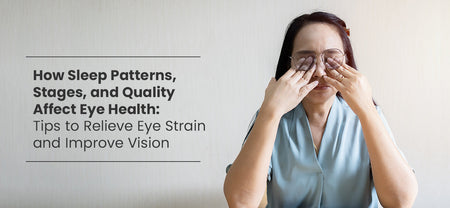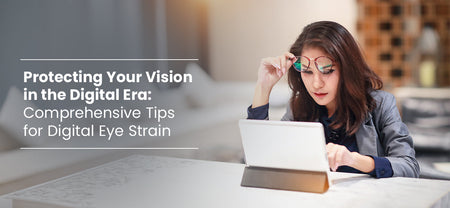In this digital world, screens are unavoidable. Whether it is working on a laptop, scrolling through a smartphone, or binge-watching your favorite series, prolonged screen time has become a daily habit. But with this increased exposure comes a common yet often ignored issue - digital eye strain.
If your eyes feel tired, dry, or blurry after long hours in front of a screen, you are not alone. Many people experience frequent eye strain, which can lead to long-term vision problems if not addressed.
The good news? You can take simple steps to protect eyes from computer screen exposure and ensure better eye care for computer users.
Let’s break down the effects of digital eye strain, how it impacts vision over time, and the best strategies for eye strain relief.
What is Digital Eye Strain?
Digital eye strain, also known as computer vision syndrome, refers to discomfort and vision problems caused by prolonged screen exposure(1). Unlike reading a book or looking at printed materials, digital screens emit blue light, reduce blinking frequency, and create glare, all of which contribute to eye strain.
Common Symptoms of Digital Eye Strain
- Dry, irritated eyes
- Blurry vision after using a screen for long hours
-
Frequent eye strain, especially after working on a computer
- Headaches caused by screen exposure
- Neck and shoulder pain from poor posture
- Difficulty focusing when shifting between digital and physical objects
If you are experiencing any of these symptoms of digital eye strain(1) regularly, your eyes may be under excessive digital stress.
The Long-Term Effects of Digital Eye Strain
Ignoring eye strain doesn’t just cause discomfort, it can lead to more serious eye health issues over time.
1. Increased Risk of Myopia (Nearsightedness)
Spending long hours on screens, especially at close distances, forces the eyes to work harder. Studies suggest that prolonged screen time may contribute to nearsightedness (myopia), especially in children and young adults(2,3).
Tip: Take regular breaks to reduce excessive focusing at short distances.
2. Chronic Dry Eyes
When using screens, people blink 50% less than usual, leading to dryness and irritation(4). Over time, chronic dry eye syndrome can develop, making it harder for your eyes to stay naturally lubricated.
Tip: Keep your eyes hydrated with artificial tears and blink frequently while using screens.
3. Sensitivity to Light (Photophobia)
Long-term exposure to blue light and glare from screens can make the eyes more sensitive to bright lights. This can make outdoor light or even regular indoor lighting feel uncomfortable(5).
Tip: Adjust screen brightness and use blue light filters to reduce strain.
4. Visual Fatigue and Focus Problems
Prolonged computer and eye interaction can weaken the eye muscles responsible for focusing. Over time, this may lead to difficulty adjusting vision when switching between screens and distant objects(1).
Tip: Give your eyes a break by looking at objects at different distances throughout the day.
5. Disrupted Sleep Cycles
Screens emit blue light, which interferes with melatonin production, making it harder to fall asleep(6). Poor sleep quality affects overall health, leading to fatigue, irritability, and even decreased cognitive performance.
Tip: Avoid screens at least one hour before bedtime or use blue light blocking glasses.
How to Avoid Digital Eye Strain and Protect Your Eyes
If you spend hours in front of a screen, here’s how you can protect eyes from computer screen exposure and minimize long-term damage.
1. Follow the 20-20-20 Rule
Every 20 minutes, look at something 20 feet away for 20 seconds. This simple habit helps relax eye muscles and prevents excessive eye strain(7).
Tip: Set reminders on your phone or computer to practice this rule.
2. Adjust Your Screen Settings
Optimizing your screen reduces frequent eye strain and discomfort.
• Brightness: Match screen brightness to the surrounding light.
• Contrast: Increase contrast for clearer text visibility.
• Font Size: Use larger fonts to avoid excessive squinting.
• Blue Light Filters: Use built-in night mode settings or blue light filter apps.
Tip: Adjust text size and background contrast to ensure easy readability.
3. Use Proper Lighting
Glare from overhead lights or windows can worsen eye strain.
• Reduce glare by positioning your screen away from direct light sources.
• Use anti-glare screen protectors to soften reflections.
• Avoid working in complete darkness as dim lighting can force your eyes to work harder.
Tip: If possible, work near natural daylight to reduce reliance on artificial lighting.
4. Keep Your Eyes Hydrated
Long screen hours reduce blinking, leading to dry eyes and discomfort.
• Blink more often to refresh your eyes naturally.
• Use lubricating eye drops if your eyes feel excessively dry.
• Stay hydrated and drink enough water every day.
Tip: Humidifiers can also help maintain moisture in dry office environments.
5. Optimize Your Workspace for Eye Comfort
Poor workstation setup can increase computer and eye fatigue.
• Screen Distance: Keep your screen at least 20 inches away from your eyes.
• Monitor Height: Keep the top of the screen at eye level to reduce neck strain.
• Ergonomic Seating: Sit with a straight back to avoid slouching.
Tip: Use an adjustable chair and desk to maintain a comfortable sitting posture.
6. Wear Blue Light Blocking Glasses
If you spend long hours on screens, blue light glasses help filter harmful light waves, reducing eye strain and minimizing sleep disruption.
• Look for lenses with anti-glare coatings.
• Use computer glasses if your job requires extended screen use.
Tip: Blue light filters on phones and laptops can also reduce strain.
7. Take Regular Breaks and Move Around
Sitting in front of a screen for hours not only affects your eyes but also your posture and circulation.
• Stand up and stretch every hour.
• Move your eyes by looking left, right, up, and down to relax the muscles.
• Roll your shoulders and stretch your neck to reduce tension.
Tip: Set a timer to remind yourself to move around and relax your eyes.
8. Consider Eye Care Supplements
Taking supplements can support long-term eye care for computer users.
• Omega-3 Fatty Acids – Helps with dry eye relief(8).
• Lutein and Zeaxanthin – Protect against blue light damage(9).
• Vitamin A & C – Essential for overall eye health(10).
Tip: If you experience frequent eye strain, talk to your doctor about adding an eye health supplement to your routine.
Final Thoughts: Prioritizing Eye Care
Long hours in front of screens are unavoidable, but digital eye strain doesn’t have to be. By making small adjustments, following the 20-20-20 rule, optimizing screen settings, staying hydrated, and using eye strain relief strategies, you can protect your vision for the future.
Taking proactive steps today will help prevent frequent eye strain and long-term vision problems. Your eyes work hard every day so give them the care they deserve!
References
-
Kaur, K., Gurnani, B., Nayak, S., Deori, N., Kaur, S., Jethani, J., Singh, D., Agarkar, S., Hussaindeen, J. R., Sukhija, J., & Mishra, D. (2022). Digital Eye Strain- a comprehensive review. Ophthalmology and Therapy, 11(5), 1655–1680. https://doi.org/10.1007/s40123-022-00540-9
-
Foreman, J., Salim, A. T., Praveen, A., Fonseka, D., Ting, D. S. W., He, M. G., Bourne, R. R. A., Crowston, J., Wong, T. Y., & Dirani, M. (2021). Association between digital smart device use and myopia: a systematic review and meta-analysis. The Lancet Digital Health, 3(12), e806–e818. https://doi.org/10.1016/s2589-7500(21)00135-7
-
Hussaindeen, J., Gopalakrishnan, A., Sivaraman, V., & Swaminathan, M. (2020). Managing the myopia epidemic and digital eye strain post COVID-19 pandemic – What eye care practitioners need to know and implement? Indian Journal of Ophthalmology, 68(8), 1710. https://doi.org/10.4103/ijo.ijo_2147_20
-
Al-Mohtaseb, Z., Schachter, S., Lee, B. S., Garlich, J., & Trattler, W. (2021). The relationship between dry eye disease and digital screen use. Clinical Ophthalmology, Volume 15, 3811–3820. https://doi.org/10.2147/opth.s321591
-
Mylona, I., Glynatsis, M. N., Floros, G. D., & Kandarakis, S. (2023). Spotlight on digital eye strain. Clinical Optometry, Volume 15, 29–36. https://doi.org/10.2147/opto.s389114
-
Aykutlu, M. Ş., Aykutlu, H. C., Özveren, M., & Garip, R. (2024). Digital media use and its effects on digital eye strain and sleep quality in adolescents: A new emerging epidemic? PLoS ONE, 19(12), e0314390. https://doi.org/10.1371/journal.pone.0314390
-
Datta, S., Sehgal, S., Bhattacharya, B., & Satgunam, P. N. (2023). The 20/20/20 rule: Practicing pattern and associations with asthenopic symptoms. Indian Journal of Ophthalmology, 71(5), 2071–2075. https://doi.org/10.4103/ijo.ijo_2056_22
-
Zhang, A. C., Singh, S., Craig, J. P., & Downie, L. E. (2020). Omega-3 Fatty Acids and Eye Health: Opinions and Self-Reported Practice Behaviors of Optometrists in Australia and New Zealand. Nutrients, 12(4), 1179. https://doi.org/10.3390/nu12041179
-
Roberts, J. E., & Dennison, J. (2015). The photobiology of lutein and zeaxanthin in the eye. Journal of Ophthalmology, 2015, 1–8. https://doi.org/10.1155/2015/687173
- Seddon JM, Ajani UA, Sperduto RD, Hiller R, Blair N, Burton TC, Farber MD, Gragoudas ES, Haller J, Miller DT, et al. Dietary carotenoids, vitamins A, C, and E, and advanced age-related macular degeneration. Eye Disease Case-Control Study Group. JAMA. 1994 Nov 9;272(18):1413-20. Erratum in: JAMA 1995 Feb 22;273(8):622. PMID: 7933422.










